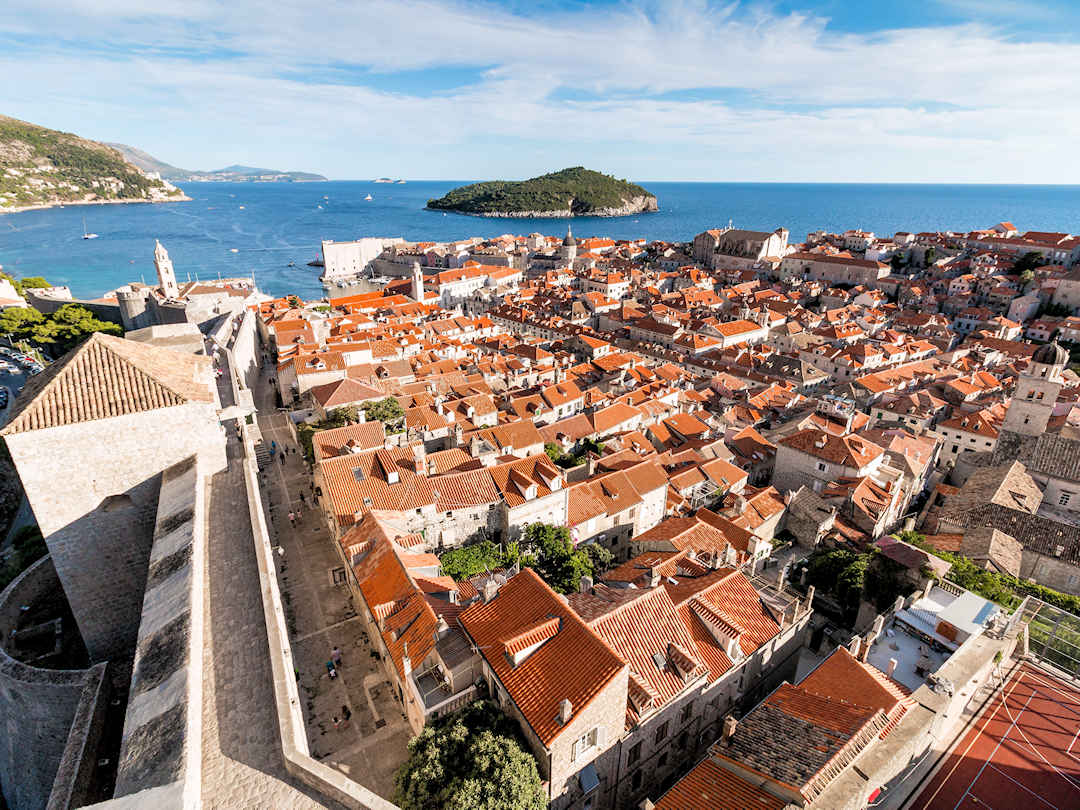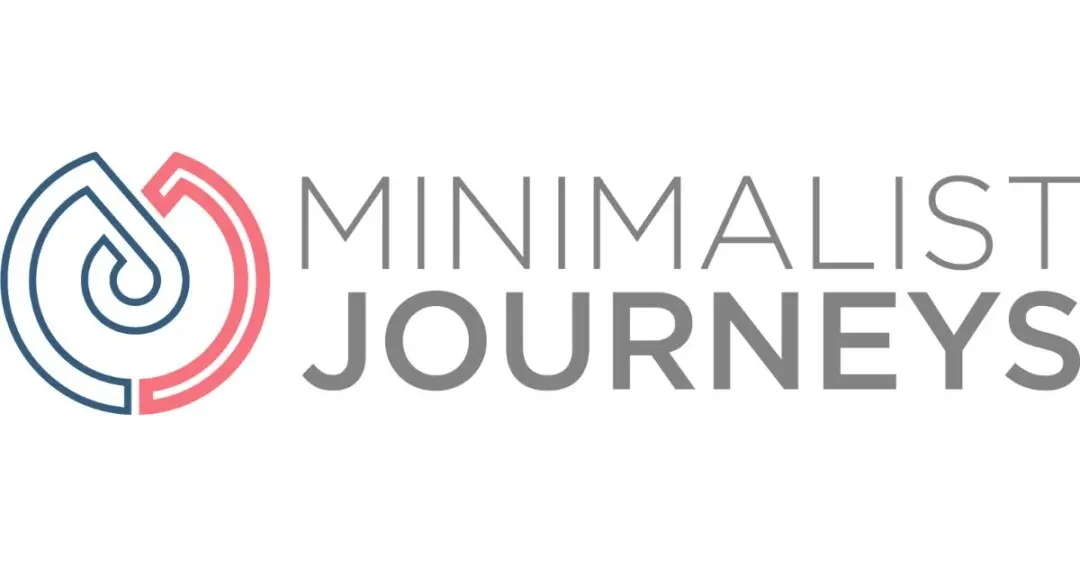This article may contain links to products and services we use and recommend. We may receive compensation when you click on links to those products. For more information, see our Disclosure Policy.
If you are planning a trip to Croatia and wonder how much to budget or you’re looking for some cost-saving tips for your upcoming trip, today’s article is for you.
Travel Cost Assumptions
When reading this article, please note that our travel costs are based on a couple travelling together. We are independent, budget-conscious travellers, researching and organising our itineraries using our go-to travel planning tools.
Our travel style is reasonably consistent wherever we go, which is excellent when you want to compare travel costs between destinations and over time:
- Accommodation: We usually stay in self-catered accommodation (homestays, locally owned guesthouses, hostels and short-term rentals) - in our room with (preferably) a private bathroom, though the kitchen and other areas may be shared.
- Dining and Groceries: We usually eat two meals a day at home. But we like to eat out once a day or at least every few days (and prefer locally owned restaurants and small eateries away from the tourist hotspots).
- Experiences: Many of our activities are free or low-cost. When we pay for attractions or activities, we are very selective, as our funds are limited, just like everyone else's (while we're travel bloggers, we seldom get a free ride).
- Transportation: We walk frequently and use public transportation wherever possible. We only occasionally hire a vehicle. The costs to enter or exit a country are not included (though we may include them for reference in the comments).
- Other: Our total daily costs also include mail scanning and forwarding services (as we are location-independent), our mobile phone and data plans, and travel insurance, although only as they relate to the time spent at our destination.
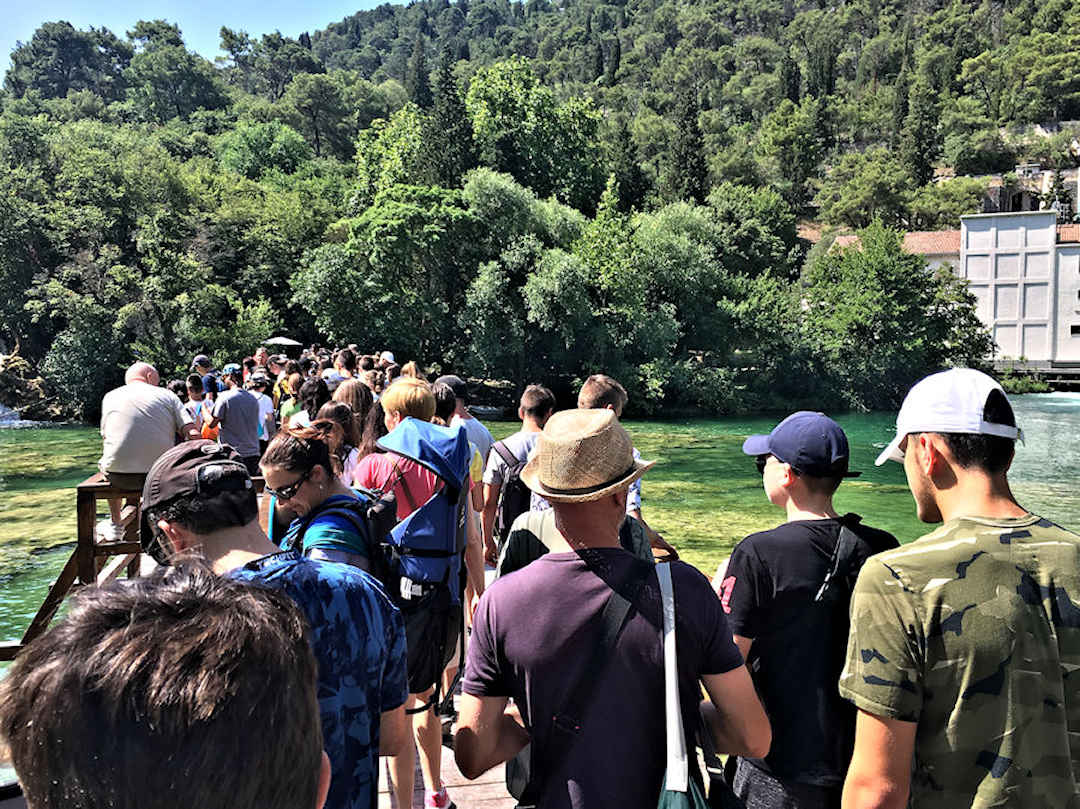
Popularity has driven up prices in places like the Krka National Park and Dubrovnik
What currency is used in Croatia?
As a member of the European Union, Croatia’s official currency is the Euro (EUR). It changed from being the Kuna on 01 January 2023.
Map of Accommodation, Points of Interest, Eateries and Transport
Below is a map of the recommended accommodations, points of interest, eateries, and transport terminals or stops mentioned in this article.
Around the world in 80+ travel movies
Looking for travel inspiration? Why not turn to the big screen? Movies can transport us to different places, spark our wanderlust and make us dream of new adventures. And with 80+ films to choose from, covering classics and hidden gems worldwide, you will be planning your next adventure in no time.
Accommodation
We recommend staying at properties where the money remains in local hands and for the most part, that means staying at short-term rental accommodation that is not a hotel chain or property owned by an overseas investor.
The average price of accommodation in Croatia for a couple was EUR42.82.
Whether you rent a private room in your host’s home or opt for a small apartment, staying with locals allows you to stay within budget while not compromising on certain comforts, such as your own bathroom and a kitchen where you can prepare meals. It also allows you to learn more about your destinations through conversations with your hosts.
We recommend the following accommodations at the destinations we stayed at:
| Name | Property Features | Location | Type | EUR Cost Per Night | Book Now |
|---|---|---|---|---|---|
| Zagrab Airbnb - No longer available as short-term accommodation | Fantastic Stay | Zagreb | One bedroom apartment | 30.35 | |
| Plitvice Airbnb | 650m from Entrance 1 | Rastovaca | Large studio room with kitchenette and ensuite bathroom | 57.43 | Book Now |
| Zadar Airbnb - No longer available as short-term accommodation | Old Town Bridge Apartment | Zadar | Large one bedroom apartment | 40.51 | |
| Skradin Airbnb | Super-equipment kitchen Modern bathroom | Skradin | One bedroom apartment | 45.94 | Book Now |
| Sibenik Airbnb | Šibenik | Large studio room with kitchen and ensuite bathroom | 40.20 | Book Now | |
| A2 - No longer available as short-term accommodation | Dubrovnik | Small one bedroom apartment | 51.69 |
How to save money on accommodation
As with any other travel expense, it's worth shopping around to find the best deal. We look across several booking platforms to find the best value-for-money option. Nightly rates are generally cheaper outside of peak season. If you can only travel during peak season, consider accommodation options that are a little further away from the main tourist attractions but offer good public transport connections.
Wherever you book, read the fine print to compare apples with apples. For example, your stay may incur extra charges (like local tourist taxes or cleaning fees). Some booking platforms include them, while in other cases, you may have to pay your host for them upon arrival.
Dining and Groceries
Dining can be quite expensive in Croatia compared to other European countries, particularly in the tourist hotspots.
The average price of dining and groceries in Croatia was EUR11.80 per person per day.
Our expenses for dining experiences in Croatia ranged
- from HRK209 (EUR28.22) for lunch at Bazza Bistro, a café in the heart of Šibenik’s Old Town
- to HRK375 (EUR50.64) for a set menu dinner at Dinner in the Garden, a small patio restaurant near the Plitvice Lakes National Park.

Our meals at Plitvice Lakes were the most expensive during our journey around Croatia but were extremely filling and tasty.
| Item | Price in EUR |
|---|---|
| Loaf of Bread (500g) | 0.84 |
| Cappuccino (regular) | 1.47 |
| Local Beer (0.5litre draught) | 2.03 |
| Milk (regular, 1 litre) | 0.83 |
| Burek with Cheese | 2.03 |
How to save money on dining and groceries
One of the reasons we travel is to experience the local cuisine, but dining out all the time can quickly get expensive. We therefore always try to book accommodation with access to a kitchen - either a private kitchenette or our host's kitchen. That way, we can store food in the fridge and make meals. Paul and I eat out only once a day (sometimes only once a week), usually at lunchtime. This allows us to sample local dishes while taking advantage of great lunch deals. It also means we don't have to roam around unknown parts of town every night in search of a restaurant.
Portion sizes in many parts of the world are usually substantial, so we frequently share a three-course meal. The same applies if you go out for dinner: Order a starter or salad and a main, and that's usually enough for two people. An added benefit is that there is less food waste.
Every country has both more expensive and less expensive supermarkets for groceries. Ask your host about the more affordable options (for example, Aldi or Lidl in many European countries) and try to avoid convenience stores as much as possible.
Transport
Flights
If you are flying from a European city to Croatia, you’ll likely arrive at one of these six international airports:
- Dubrovnik (IATA Code: DBV)
- Pula (IATA Code: PUY)
- Rijeka (IATA Code: RJK)
- Split (IATA Code: SPU)
- Zadar (IATA Code: ZAD)
- Zagreb (IATA Code: ZAG)
All of them are serviced by budget airlines from other European cities, so chances are your flight to Croatia won’t break the bank, as long as you avoid the peak summer season (July/August).
How to find the best deals on rental cars
Most of the time, we use public transport to get us around. But occasionally, hiring a car or scooter just makes it easier or gets us to places we couldn't go without a set of wheels. Whenever we do hire a vehicle, our first point of call are local rental providers. A quick Google Maps search shows who's near us. We then check the reviews and only contact those other travellers had good experiences with.
If we can't find anyone we're comfortable with, we search for deals on aggregator websites. We've used Rentalcars.com and DiscoverCars.com in the past and had only good experiences with them. Both partner with trusted brands like Hertz, Avis, Budget or Europcar (and in some locations even local providers) - so you can compare car hire options in a similar way you'd compare accommodation offers across Agoda and Booking.com.
How to save money on transportation
Being flexible pays off when it comes to transportation, particularly air travel. If possible, travel outside of peak season. If you can't, fares might still be cheaper at certain times of the week or even during specific hours of the day, so check websites like Skyscanner or Google Flights for the best deals. These websites allow you to compare monthly prices and options on any given date.
If several airports are near your home or destination, compare the prices of the different options to find the most affordable one. For example, flying to Mykonos and taking the ferry to Santorini may be cheaper than flying directly from your home airport to Santorini. If we don't know how to get from A to B, we check Rome2Rio - an aggregator website that shows connections across multiple modes of transport (with price estimates).
Air Travel
Ideally, research with your browser in incognito mode, as cookies will show booking sites how interested you are in making a particular trip, which may affect the price quoted. That applies to all online travel agents (OTAS), not just airlines. If you find a good deal, book it there and then, as prices change constantly:
- The best fares usually go first, so planning is essential for air transportation.
- The same applies to air points or miles, as only a limited number of seats are available on each flight.
If you plan to travel across multiple continents, you may want to compare passes that offer multiple destinations as a package, such as round-the-world (RTW) fares provided by OneWorld or Star Alliance members. If you travel during peak season, these multi-destination packages may be a better deal than booking each leg individually. You can do overland sections on RTW tickets, too, which means you could supplement your RTW ticket with bus and train rides or cheap flights between destinations.

You don't need to resort to hitchhiking to save money on transportation | Photo by Dmitry Shulga on Unsplash
Vehicle Rental (including Relocations)
Unless your trip takes you across oceans, another way to save on transportation is to look for vehicle or motorhome relocations. Websites in many countries offer massively discounted one-way rates (often including fuel and/or insurance) to those driving a vehicle or motorhome from A to B within a specific period. These deals are relatively last-minute, and A and B are usually more significant transport hubs. However, if that's an option, consider searching for vehicle or motorhome relocation services at your destination.
Speaking of vehicles, if you plan to hire a car at your destination, it's also a good idea to shop around. We often use aggregator websites that allow us to search across multiple car rental companies simultaneously.
Hitchhiking
A final option to save on transport costs is… to hitch a ride. While Paul and I did it safely in Dominica on a public holiday (when there was no other option) and have taken plenty of people along in our campervan in New Zealand, there are many countries where we wouldn't feel safe hitchhiking. Judge for yourself where and when you can and can't do it.
Bus Services
Croatian cities are well-connected by bus. Intercity bus travel is generally cheap, but the service quality of the bus operators can vary quite a bit.
Note that in addition to your bus fare, you are usually also charged:
- a bus station fee (usually around EUR1 per person), and
- a luggage hold fee (as the name suggests, for luggage going into the hold of the bus – usually around EUR1 for a regular suitcase).
You can save the latter if you travel with a travel pack or bag that you take with you on board.
In Zagreb, bus and tram tickets can be purchased at newsstands and from the driver, however, purchasing from the driver is generally more expensive. Zagreb Public Transport is free with ZagrebCard.

Zagreb has an extensive and efficient public transport network
Uber and Taxis
Croatia is the only Balkan country where Uber is available, which is a great thing, especially given the negative reputation that taxis have with tourists. You know the price of the ride before you hop into the vehicle. In general, we prefer not to take taxis, especially when travelling from the airport to our accommodation.
Train Services
Croatia’s train network isn’t the most extensive, unfortunately. The most popular routes are those between Zagreb and Split, and Zagreb and Rijeka. We took the train from Šibenik to Split and found it to be comfortable and on time. Ticket prices are relatively low compared to most Western European countries.
Ferry Services
Croatia has an extensive ferry network along the Adriatic coast. We decided to take the ferry from Split to Dubrovnik – both to circumnavigate a double-border crossing (as Dubrovnik is an exclave sandwiched between Bosnia and Herzegovina, and Montenegro) and to experience the gorgeous coastline from the sea. It took longer than the bus but was more comfortable and enjoyable.
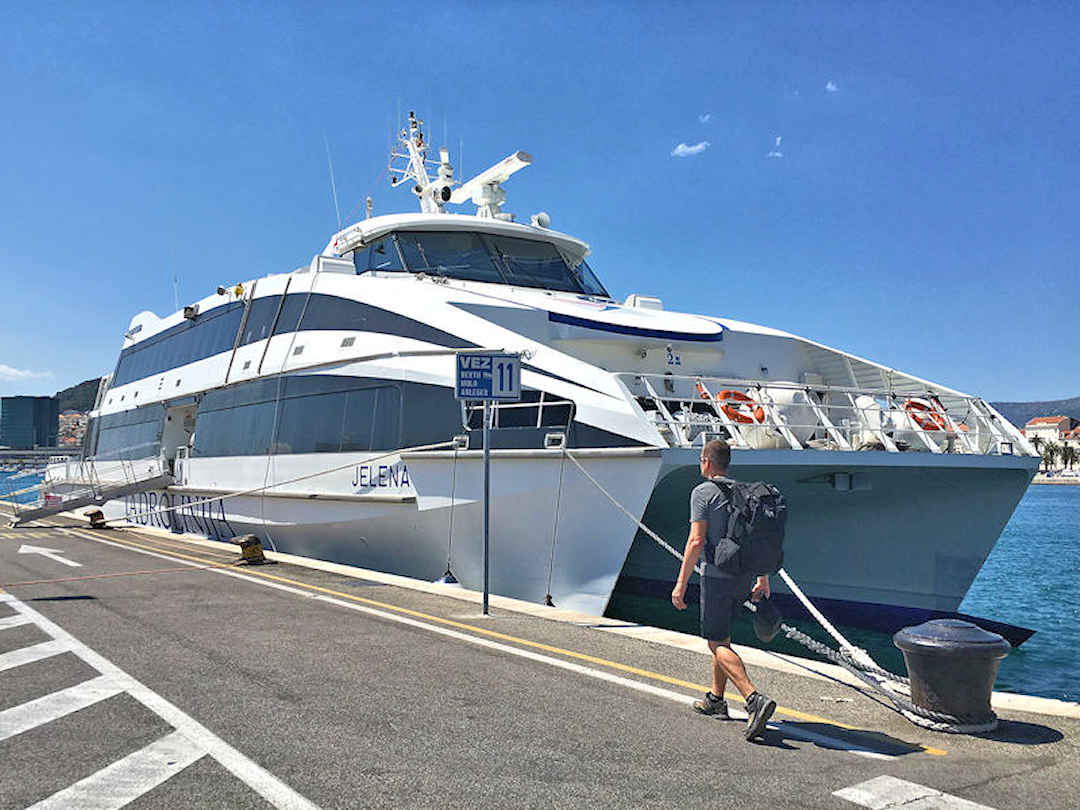
Why not take a ferry between Split and Dubrovnik? It is very scenic and saves you two border crossings.
Experiences
You are spoilt for choice when it comes to tourist attractions and activities in Croatia:
- from National Parks like Plitvice Lakes, Krka, the Kornati Islands or Telascica, which all require you to pay entry fees
- to stunning Roman and Medieval Old Towns that can be explored on foot, self-guided or on free/low-cost walking tours, and
- gazillion other options in between.
Croatia’s Free Museum Night, where museums and galleries in the major cities are open free of charge, usually happens at the end of January. So, if you happen to be in Croatia around that time keep an eye out for it.
And if you are interested in some other activities, here are some curated options we think are appropriate from our friends at Get Your Guide.
How to save money on experiences
Look for free and low-cost experiences
Many activities (and some of our most treasured experiences) have been free or cost little. On our journeys, we have
- Visited many museums free of charge (including the Colosseum and Forum in Rome, which are free on the first Sunday of the month);
- Attended free guided walking tours around the world (you tip at the end based on your budget and how much you liked the tour);
- Did countless self-guided walks and used public transport to get to know a city;
- Hiked in the Andes in Ecuador and climbed volcanoes in the Caribbean;
- Swam and snorkelled at countless beaches, using tree shade rather than paying for parasols and
- Attended free street performances and danced with locals in Argentina, Cuba and the Dominican Republic.
Search for free activities at your destination; chances are someone has already made a nice list.
Be selective about paid experiences
Paying for activities and attractions can add up quickly. Therefore, look out for special offers and discount coupons. If you travel in a group, you may also pay to book a private tour and share the cost. And finally, shop around - here are some of the OTAs we use and can recommend:
Miscellaneous
There are always expenses that don’t quite fit the major expense categories we talked about above. There include
- the cost of your travel insurance
- the cost of visas you may need to enter a country
- foreign exchange-related fees, and
- tips.
When you plan your trip, always budget (at least) an additional 10% for miscellaneous expenses on top of the big four items of accommodation, dining and groceries, transportation and activities. Budget more if you have the habit to buy souvenirs and trinket gifts for your loved ones (or yourself).
Securing your currency needs overseas can be expensive, but it doesn't have to be. We've saved a significant amount of money over the years simply by knowing what to do (or, more importantly, what not to do).
- How not to get caught out by alarming FX rates and exorbitant commissions;
- How to exchange cash on your overseas trip.
- Which debit/credit card is best for your overseas trip, and
- How do you avoid unnecessary fees when withdrawing cash?
Suppose you need to transfer money to pay for your travels upfront. In that case, we recommend Wise and XE Money Transfer (we use them interchangeably, depending on which one offers the better foreign exchange rates and lower commissions).
How much should I budget for a trip to Croatia?
Below are our travel costs when we visited Croatia. We spent a total of 25 nights in the country: 7 nights in Zagreb, 3 nights at Plitvice Lakes National Park, 5 nights in Zadar, 3 nights in Skradin/Krka National Park, 5 nights in Šibenik and 2 nights in Dubrovnik.
Our daily travel expenses in Croatia were USD54.59 / EUR48.26 per person per day, slightly above our general budget of USD50.
| Category | EUR per person per day | Percentage of total |
|---|---|---|
| Accommodation | 21.73 | 45% |
| Dining and Groceries | 11.80 | 24% |
| Transport | 3.40 | 7% |
| Experiences | 7.50 | 15% |
| Miscellaneous | 3.82 | 9% |
| Total per person per day | 48.26 |
Do I need to tip for services in Croatia?
As non-Americans, we are not used to tipping for services, whether in a restaurant, taxi or anywhere else. And while it is not expected to tip for café or restaurant services in Croatia, it is always appreciated. Don’t do it out of habit, but if the food and service exceeded your expectations.
A lot of websites recommend leaving a 10% gratuity, but in the end, give what you feel is appropriate. If you do decide to leave a tip for excellent service, and you pay with a credit card, there is a good chance you won’t be able to add it to the payment process. Leave cash instead.
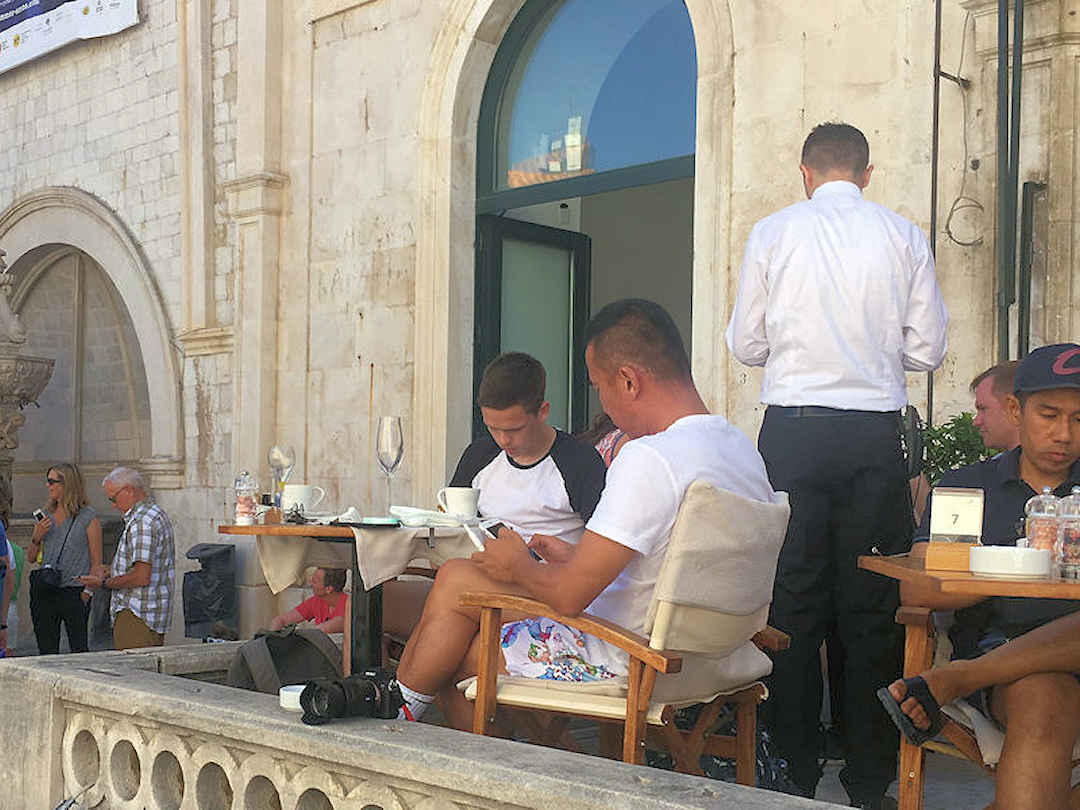
A tip is not expected in Croatia, but it is always appreciated
Stay connected (almost) anywhere with Airalo eSIM
We use Airalo eSIMs (on Sandra's Samsung Galaxy S25) whenever we are overseas. Activating it ahead of time means we have instant internet access as soon as we land - no need to join queues to buy a physical SIM before leaving the airport. While Airalo works in over 200 countries, we couldn't use it when visiting the Yemeni island of Socotra. So, do check the country list before you buy. Also, check if your phone is eSIM-enabled.
Exclusive discount codes for our audience
If you're new to Airalo, use the code NEWTOAIRALO15 to receive 15% discount on Airalo eSIMs. If you're already an Airalo customer, use the code AIRALOESIM10 to enjoy a 10% discount on eSIMs. Offers are valid until 31 December 2026!
This brings us to our final point.
How much cash do I need in Croatia?
From a safety point of view, we like to have as little cash as possible on us, yet enough to not feel uncomfortable.
Of the expenses incurred in Croatia, we paid 28% in cash. The biggest cash amount was a payment of HRK1,500 (EUR202.55) for five nights of accommodation in Zadar.
How much did it cost you to explore Croatia?
I wrote this Croatia travel cost guide based on our experience. If you have explored Croatia recently and you have something to add about your travel costs, please feel free to contact me. If you liked my travel cost saving tips and found them helpful, I would appreciate it if you could share them with your friends and family via the Share buttons below. Even better, link to the page from your personal blog or social media platforms.

